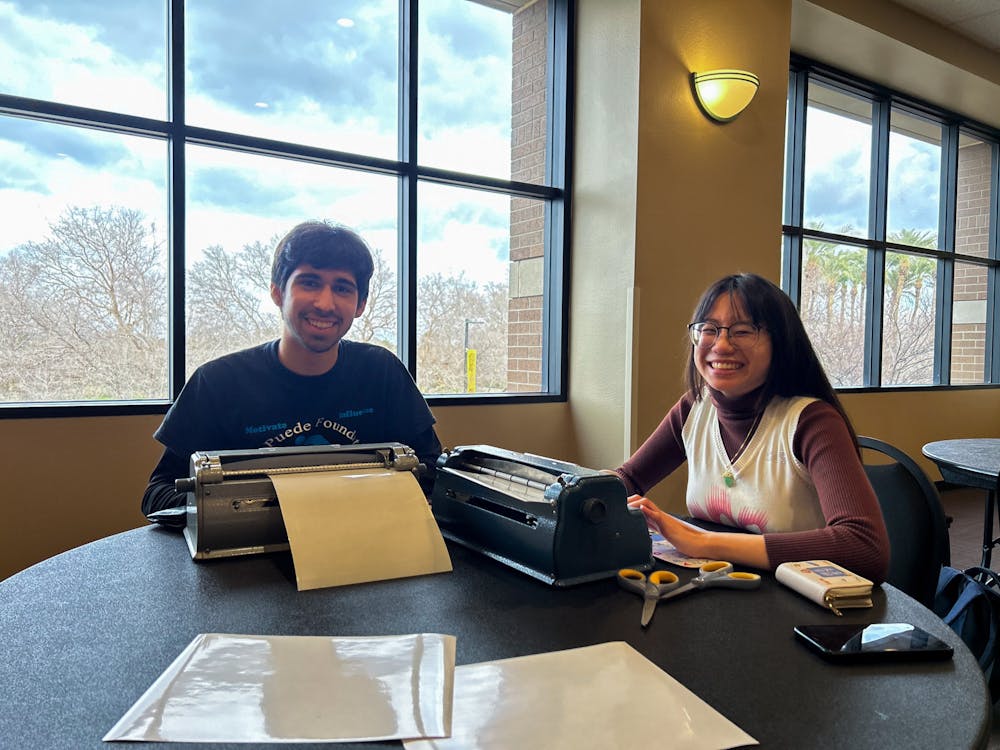A symphony of metal keys clicking and chiming echoes through the nearly empty classroom. As each key clatters, a corresponding hole punches through the thick, waxy paper, leaving a slight indentation behind.
The commotion is not coming from a typewriter — but from a Braille writer.
Braille Devils at ASU hosted a Braille book creation event at the University Center Building on the West campus Wednesday, where children's books were adapted into Braille books and will later be donated to The Foundation for Blind Children in honor of Braille Literacy Month.
Students adapted children's books about animals, shapes, numbers, and Disney characters.
Braille is a written language for the blind and visually impaired. Letters or characters are represented by patterns of raised dots that are felt by the fingertips.
Athena Garcia, a junior studying special education with a focus on visual impairment, is the president of Braille Devils, a new club on campus that started only last Fall.
She said Braille Devils raises awareness about visually impaired students on campus.
“I knew that there was a high need for disability awareness and advocacy for the blind and low vision community,” Garcia said. “There just isn’t a lot of representation on campus.”
Wednesday’s event taught students how to write in Braille using a Braille writer and educated students on the importance of accessibility.
“Awareness is really important because of the challenges that people with disabilities face and the misconceptions,” Garcia said. “It is really important to advocate for the disability community and break the barriers and misconceptions that students with visual impairments face.”
Melissa Woo, the vice president of Braille Devils and a senior studying psychology and neuroscience, said that visual impairment is a diverse spectrum and that it does not discriminate.
"It is important to have these resources, like Braille, because visual impairments are a spectrum of vision loss," Woo said. "Some people have it in both eyes, or it is muscular, or it's only central vision or peripheral vision, or you’re just born with it."
Woo, who is learning how to read Braille, said that learning the language has offered a greater sense of community.
“Not every visual person has to learn Braille, but it is good to practice and to have,” Woo said. “It’s an art, and it helps to understand other communities and raise awareness.”
Fabian Sanchez Suarez, a graduate student studying computer engineering, became a club member through his girlfriend, Woo.
He said that learning Braille helps him understand the many options visually impaired people have when interacting with the world around them.
“I was interested in learning more about how she sees the world because she sees it in a different way,” Sanchez Suarez said. “That way, in the future, I can also help with accommodations and stuff.”
Students with low vision might use magnifiers, reading aids, or audio descriptions as one of many assistance resources.
“Braille is just one of the many technologies that you can use,” Woo said. “As an individual where things are not very accessible, it is nice to know that there are alternatives.”
Students were given a Braille writer, paper and a children’s book to translate at the event.
A standard Braille writer is a typewriter-esque technology fit with six keys. Each key corresponds to a dot in a braille cell, representing each character in the Braille alphabet. A Braille writer also includes a backspace key and a space bar.
Garcia learned how to read Braille at age 21 through the nonprofit Foundation for Blind Children, the same organization to which the books made on Wednesday are being donated.
She said that the creation of Braille Devils was inspired by her own need for advocacy growing up.
“When I was in school, I wasn’t provided with the accommodations, and they weren’t aware that I had a visual impairment,” Garcia said. “So, I sort of fell through, and that’s why I want to be a student’s advocate and help them.”
The club officially began in the fall semester but is looking to expand in upcoming semesters.
“It is a small club,” Woo said. “Our goal is to have more outreach and do intercampus work, but this semester, we are working to do more meetings and events and collaborate with other organizations.”
Edited by Katrina Michalak, Walker Smith and Caera Learmonth.
Reach the reporter at efoxmill@asu.edu and follow @emilyfoxmillion on X.
Like The State Press on Facebook and follow @statepress on X.





